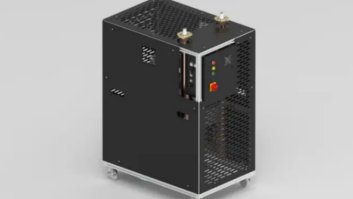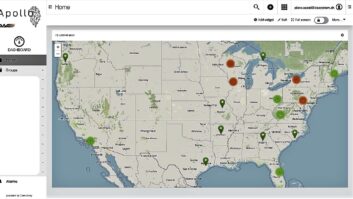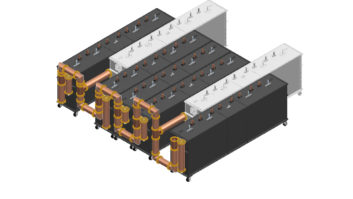The industry is reacting to the news that transmission antenna manufacturer Dielectric plans to close its doors in June.
Though the company made radio, TV and wireless antennas, it relied heavily on its TV business in later years, according to sources contacted by both Radio World and TV Technology. Dielectric’s impending closure was confirmed on Friday, two weeks after the FCC issued a freeze on full-power and Class A TV station modification applications. The commission did so in anticipation of the incentive auction, tentatively scheduled for June of 2014.
That seemed to be the tipping point, sources agreed. A majority of TV stations operated on a staggered 10- to 20-year replacement cycle for transmission antennas and peripherals. The 2009 DTV transition threw that into disarray.
“In 1998, the top 10 markets went, and then the market took a dip, and then between 2000 and 2005, it went through the roof,” prior to the initial 2006 deadline said an engineer who wished to remain anonymous. “Then it declined and picked up again before 2009. There was a pretty steep decline after that.”
It will be difficult to complete the post-incentive auction channel repack in three years, as Congress has mandated, according to broadcast engineering consultant Gary Cavell of Cavell, Mertz & Associates, adding the FCC’s proposed 18-month timeline is not going to get met. “They were one of the go-to companies. There’s going to be a supply-and-demand issue.”
Jay Adrick, now a technology advisor to Harris Broadcast, said Dielectric’s closure was a “grave concern for the industry. I have repeatedly told the commission in my filings as well as the seminar I did with them last June … and will remind them again, that three years isn’t going to cut it,” he said. “This further supports that position.”
Around 63% of full-power TV stations in the country have Dielectric antennas, according to a search of the FCC’s broadcast database system by Cavell Mertz’s Michael D. Rhodes. The next-largest provider has a 20% market share. All other manufacturers combined comprise the remaining 17%.
Sinclair’s Mark Aitken said his group had five projects under way that are “now dead.”
“The FCC freeze came as a total surprise for many, and has had a chilling effect on many critical broadcast industry providers,” said Aitken, Sinclair’s vice president of advanced technology. “This ‘guillotine’ approach at break-neck speed to complete the most complex spectrum auction ever devised is having the unintended consequence of ‘shutting down’ entire parts of the industry that will be required in any repack scenario. The loss of crucial providers spells delay in any repack scenario.”
In addition to antennas, Dielectric was a major supplier of TV transmission line, mast filters, combiners and other related equipment. Each TV station requires a customized antenna package based on frequency, coverage area, power and tower configuration. All replacements and upgrades require an engineering study to make sure the work plan meets federal regulations, structural standards and technical requirements. Dielectric also conducted those studies.
“There’s not an inventory just lying there,” Cavell said. “Even if Dielectric were still in business, you would still have to ramp up production, train people, import the brass, the copper, the materials…. and not that many antenna crews are certified to work more than 500 feet above the ground. Those guys have scattered.”
The number of broadcasters that will be moved to new frequencies remains unknown, because the auction is designed so stations can participate anonymously. The estimate of participating stations now stands at around 200 out of some 1,735 full-power licensees. The FCC’s goal of reclaiming TV Channels 31–51 would require 672 full-power TV stations either to be moved or shut down, according to a study by the National Association of Broadcasters. A total of 174 stations were relocated in 2009.
Dielectric, located about 22 miles north of Portland, was founded more than 60 years ago by Dr. Charles Brown to manufacture transmission lines for military radar systems. Dielectric laid off 31 employees in December 2009, and another 46 in August 2011, according to the Lakes Region Weekly.The staff count has been reduced by nearly two-thirds since 2000, when the operation employed 157 people, according to The Portland Press Herald.
SPX acquired Raymond, Maine-based Dielectric in 2001. SPX said in a statement that it’s providing outplacement services to its impacted U.S. employees and they are being encouraged to apply for open positions at other SPX-owned businesses, including Radiodetection Ltd. … which also has a presence in Raymond. SPX stated the company filed a [Worker Adjustment and Retraining Notification] on April 19.
Beginning that day, the phones at Dielectric went directly to voicemail. “You have reached SPX Communications Technologies, formerly known as Dielectric Technologies … SPX has announced its decision to close the Dielectric broadcast, TV, radio and wireless operation in Raymond effective June 29, 2013. We will be unavailable until Thursday, April 25 to answer any inquiries regarding this process …”
—Leslie Stimson contributed to this article.
Related:
Dielectric to Close











